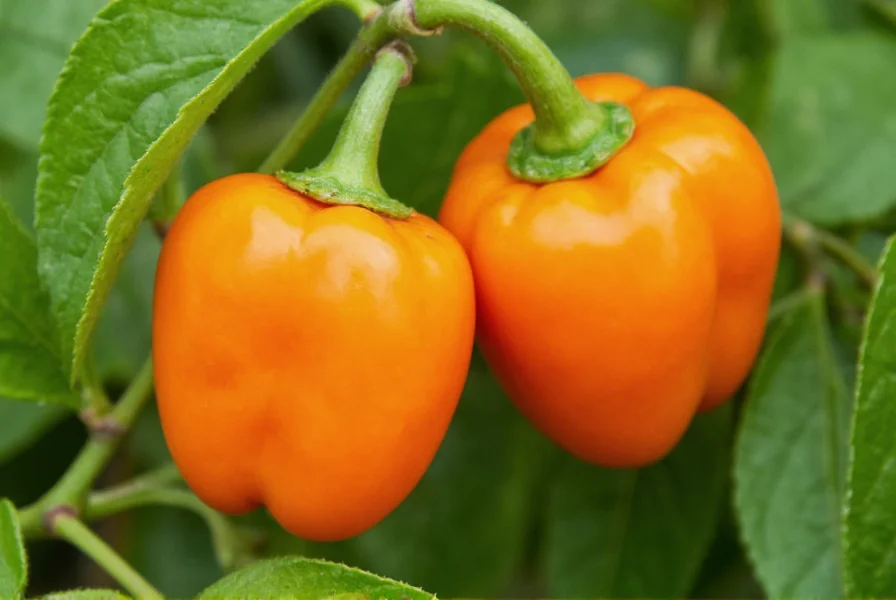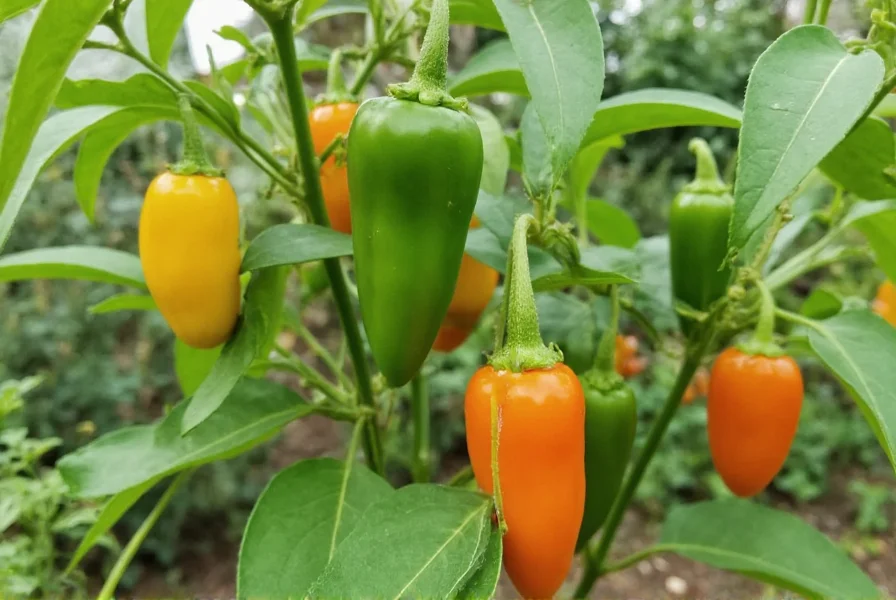The jigsaw pepper has become increasingly popular among chili enthusiasts for its unique appearance and balanced heat profile. Unlike many super-hot peppers that prioritize pure heat, the jigsaw delivers a more nuanced flavor experience while still providing substantial spiciness. This article explores everything you need to know about this fascinating cultivar, from its botanical characteristics to practical growing and culinary applications.
Botanical Classification and Origin
Scientifically classified as Capsicum chinense, the jigsaw pepper belongs to the same species as habaneros, Scotch bonnets, and ghost peppers. Despite the "chinense" designation suggesting Chinese origin, all C. chinense varieties actually originated in the Amazon basin before spreading throughout the Americas.
The jigsaw pepper is a relatively recent cultivar developed through selective breeding. Its distinctive "jigsaw" appearance comes from the irregular, raised patterns that form on the fruit's surface as it matures, resembling interlocking puzzle pieces. This unique characteristic makes it easily distinguishable from other C. chinense varieties.
Physical Characteristics
Jigsaw peppers typically measure 1.5 to 2.5 inches in length with a width of approximately 1 to 1.5 inches. The fruits start green and gradually develop vibrant orange or red hues as they mature. What truly sets them apart is their textured surface featuring:
- Irregular, raised patterns resembling puzzle pieces
- Slightly bumpy texture compared to smoother habaneros
- Variable coloration with possible streaks during ripening
- Distinctive shape that's somewhat lantern-like but with unique surface features
| Characteristic | Jigsaw Pepper | Habanero | Ghost Pepper |
|---|---|---|---|
| Scoville Heat Units | 100,000-350,000 | 100,000-350,000 | 855,000-1,041,427 |
| Typical Shape | Lantern with textured surface | Lantern/smooth | Bumpy lantern |
| Flavor Profile | Fruity with citrus notes | Tropical fruit | Fruity then intense heat |
| Maturity Time | 90-100 days | 90-120 days | 100-120 days |
Heat Level and Flavor Profile
Understanding the jigsaw pepper heat level is essential for both growers and culinary enthusiasts. With a Scoville rating between 100,000 and 350,000 units, it sits firmly in the super-hot category but offers more consistency than some varieties. The heat builds gradually, starting with the characteristic fruity flavor of C. chinense peppers before delivering significant warmth that lingers moderately.
The flavor profile distinguishes jigsaw peppers from many other hot varieties. They offer:
- Pronounced citrus and tropical fruit notes
- Subtle floral undertones
- Less earthy than ghost peppers
- More complex than standard habaneros
This balanced heat-to-flavor ratio makes jigsaw peppers particularly valuable for creating hot sauces where flavor matters as much as heat. When using jigsaw peppers in cooking, remember that the heat concentrates in the placenta and seeds, while the flesh contains most of the flavor.
Growing Jigsaw Peppers Successfully
For gardeners interested in how to grow jigsaw peppers, these plants require similar conditions to other C. chinense varieties but with some specific considerations. They thrive in warm climates with long growing seasons, making them ideal for southern regions of the United States or greenhouse cultivation elsewhere.
Key growing requirements include:
- Soil temperature of at least 70°F (21°C) for germination
- Full sun exposure (6-8 hours daily)
- Well-draining, slightly acidic soil (pH 6.0-6.8)
- Consistent moisture without waterlogging
- 85-95°F (29-35°C) daytime temperatures for optimal growth
When starting jigsaw pepper seeds, begin indoors 8-10 weeks before the last frost date. The seeds can be slow to germinate, often taking 2-4 weeks. Using a heat mat can significantly improve germination rates. Once seedlings develop their second set of true leaves, transplant them into larger containers before moving outdoors after all danger of frost has passed.
For those seeking jigsaw pepper growing tips, proper spacing is crucial—allow 18-24 inches between plants to ensure adequate air circulation and prevent disease. Regular feeding with a balanced fertilizer throughout the growing season will support healthy fruit production. Most jigsaw pepper plants reach 24-36 inches in height and benefit from staking as the fruits develop.

Culinary Applications and Recipe Ideas
The unique flavor profile of jigsaw peppers makes them versatile in the kitchen. Their jigsaw pepper culinary uses span various cuisines and preparations. Unlike some extremely hot peppers that overwhelm other flavors, jigsaw peppers contribute both heat and distinctive taste.
Popular culinary applications include:
- Hot sauces and salsas where flavor complexity matters
- Marinades for meats, particularly chicken and pork
- Infused oils and vinegars
- Specialty hot honey preparations
- Garnishes for creative cocktails
When working with jigsaw peppers, always wear gloves to protect your skin from capsaicin oils. Remove seeds and membranes for milder heat, or include them for maximum spiciness. The peppers freeze well for year-round use—simply place whole peppers in airtight containers or freeze chopped peppers in ice cube trays with water.
Where to Find Jigsaw Peppers
Locating jigsaw pepper seeds or plants can be challenging since they're not as widely available as mainstream varieties. Your best options for where to buy jigsaw pepper seeds include:
- Specialty online seed retailers focusing on heirloom and hot peppers
- Pepper enthusiast forums and exchanges
- Local farmers markets in regions with active chili growing communities
- Niche nurseries specializing in unusual pepper varieties
When purchasing seeds, verify the seller's reputation and look for germination rate information. Some sellers may mislabel peppers, so seek out reviews or recommendations from experienced growers. Fresh jigsaw peppers remain relatively rare in commercial markets due to their specialty nature, making home cultivation the most reliable source for many enthusiasts.

Comparing Jigsaw Peppers to Similar Varieties
Understanding jigsaw pepper vs habanero differences helps growers and cooks select the right pepper for their needs. While both belong to the C. chinense species, they exhibit notable distinctions:
- Appearance: Jigsaw peppers have distinctive textured surfaces while habaneros are typically smooth
- Heat consistency: Jigsaw peppers often show more consistent heat levels than habaneros
- Flavor: Jigsaw peppers tend to have more pronounced citrus notes compared to habaneros' tropical fruit profile
- Shape: Jigsaw peppers maintain a more uniform lantern shape without the occasional pointed tips of habaneros
Compared to ghost peppers (Bhut Jolokia), jigsaw peppers offer significantly less heat while providing superior flavor complexity. Ghost peppers register much higher on the Scoville scale (855,000-1,041,427 units) with a more one-dimensional heat profile that can overwhelm other flavors.
Conclusion
The jigsaw pepper represents an exciting addition to the world of specialty hot peppers, offering both visual interest and culinary versatility. Its distinctive appearance, reliable heat level, and complex flavor profile make it valuable for growers and cooks seeking something beyond standard supermarket peppers. Whether you're an experienced chili grower or a culinary enthusiast looking to expand your flavor palette, the jigsaw pepper deserves consideration for your garden or kitchen repertoire.
How hot is a jigsaw pepper compared to common peppers?
Jigsaw peppers range from 100,000 to 350,000 Scoville Heat Units, making them approximately 10-40 times hotter than jalapeños (2,500-8,000 SHU) and comparable to habaneros. They're significantly milder than ghost peppers (855,000-1,041,427 SHU) but hotter than standard Scotch bonnets.
What makes jigsaw peppers different from other hot peppers?
Jigsaw peppers are distinguished by their unique surface texture featuring irregular, puzzle-like patterns. They also offer a more consistent heat level and pronounced citrus flavor notes compared to many other C. chinense varieties. Unlike some super-hots that prioritize pure heat, jigsaw peppers balance significant spiciness with complex flavor.
How long does it take to grow jigsaw peppers from seed to harvest?
Jigsaw peppers typically require 90-100 days from transplanting to reach maturity. When growing from seed, add 8-10 weeks for indoor germination and seedling development. Total time from seed to harvest usually ranges from 130-150 days, depending on climate conditions and growing methods.
Can jigsaw peppers be grown in containers?
Yes, jigsaw peppers grow well in containers with proper care. Use pots that are at least 5 gallons in size with excellent drainage. Container-grown plants may require more frequent watering and feeding than in-ground plants. Place containers in locations receiving 6-8 hours of direct sunlight daily for best results.
What are the best ways to use jigsaw peppers in cooking?
Jigsaw peppers excel in applications where both heat and flavor matter. They're particularly well-suited for hot sauces, salsas, and marinades. Their citrus notes complement seafood and poultry dishes. For milder applications, remove seeds and membranes. The peppers freeze well for year-round use in various culinary creations.
Frequently Asked Questions
How hot is a jigsaw pepper compared to common peppers?
Jigsaw peppers range from 100,000 to 350,000 Scoville Heat Units, making them approximately 10-40 times hotter than jalapeños (2,500-8,000 SHU) and comparable to habaneros. They're significantly milder than ghost peppers (855,000-1,041,427 SHU) but hotter than standard Scotch bonnets.
What makes jigsaw peppers different from other hot peppers?
Jigsaw peppers are distinguished by their unique surface texture featuring irregular, puzzle-like patterns. They also offer a more consistent heat level and pronounced citrus flavor notes compared to many other C. chinense varieties. Unlike some super-hots that prioritize pure heat, jigsaw peppers balance significant spiciness with complex flavor.
How long does it take to grow jigsaw peppers from seed to harvest?
Jigsaw peppers typically require 90-100 days from transplanting to reach maturity. When growing from seed, add 8-10 weeks for indoor germination and seedling development. Total time from seed to harvest usually ranges from 130-150 days, depending on climate conditions and growing methods.
Can jigsaw peppers be grown in containers?
Yes, jigsaw peppers grow well in containers with proper care. Use pots that are at least 5 gallons in size with excellent drainage. Container-grown plants may require more frequent watering and feeding than in-ground plants. Place containers in locations receiving 6-8 hours of direct sunlight daily for best results.
What are the best ways to use jigsaw peppers in cooking?
Jigsaw peppers excel in applications where both heat and flavor matter. They're particularly well-suited for hot sauces, salsas, and marinades. Their citrus notes complement seafood and poultry dishes. For milder applications, remove seeds and membranes. The peppers freeze well for year-round use in various culinary creations.











 浙公网安备
33010002000092号
浙公网安备
33010002000092号 浙B2-20120091-4
浙B2-20120091-4